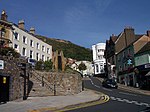Great Malvern Priory
1085 establishments in England1541 disestablishments in EnglandBenedictine monasteries in EnglandBuildings and structures in Malvern, WorcestershireChristian monasteries established in the 11th century ... and 8 more
Church of England church buildings in WorcestershireGrade I listed churches in WorcestershireMajor Churches NetworkMonasteries dissolved under the English ReformationMonasteries in WorcestershirePre-Reformation Roman Catholic cathedralsTourist attractions in WorcestershireUse British English from September 2019

Great Malvern Priory in Malvern, Worcestershire, England, was a Benedictine monastery (c. 1075 – 1540) and is now an Anglican parish church. In 1949 it was designated a Grade I listed building. It is a dominant building in the Great Malvern Conservation area. It has the largest display of 15th-century stained glass in England, as well as carved miserichords from the 15th and 16th century and the largest collection of medieval floor and wall tiles. In 1860 major restoration work was carried out by Sir George Gilbert Scott. It is also the venue for concerts and civic services.
Excerpt from the Wikipedia article Great Malvern Priory (License: CC BY-SA 3.0, Authors, Images).Great Malvern Priory
Priory Steps, Malvern Hills Great Malvern
Geographical coordinates (GPS) Address External links Nearby Places Show on map
Geographical coordinates (GPS)
| Latitude | Longitude |
|---|---|
| N 52.110477777778 ° | E -2.3285888888889 ° |
Address
Great Malvern Priory
Priory Steps
WR14 3ES Malvern Hills, Great Malvern
England, United Kingdom
Open on Google Maps










